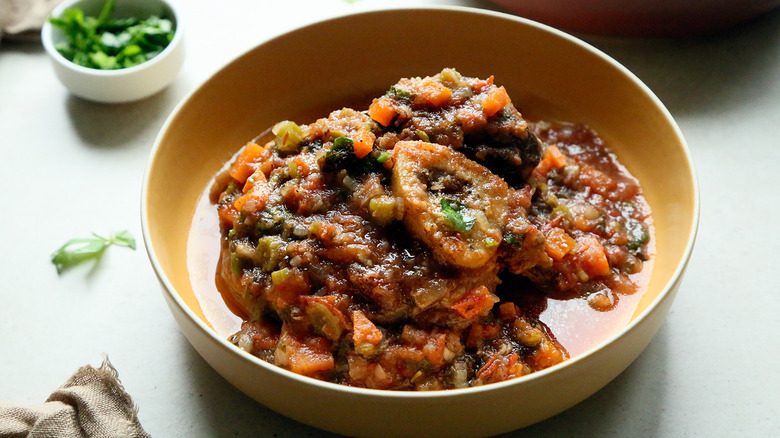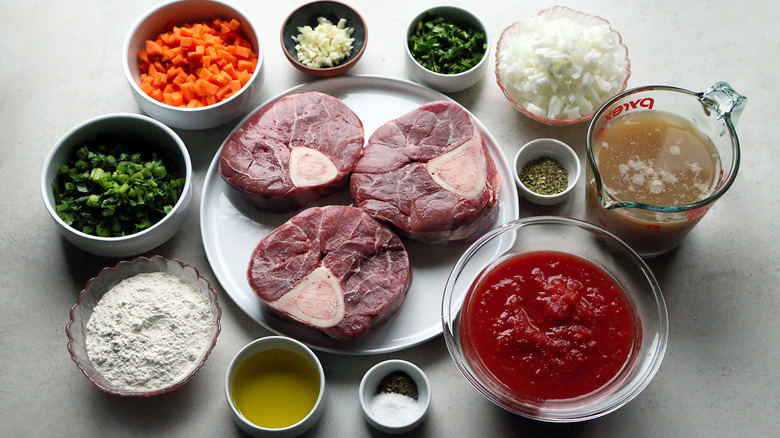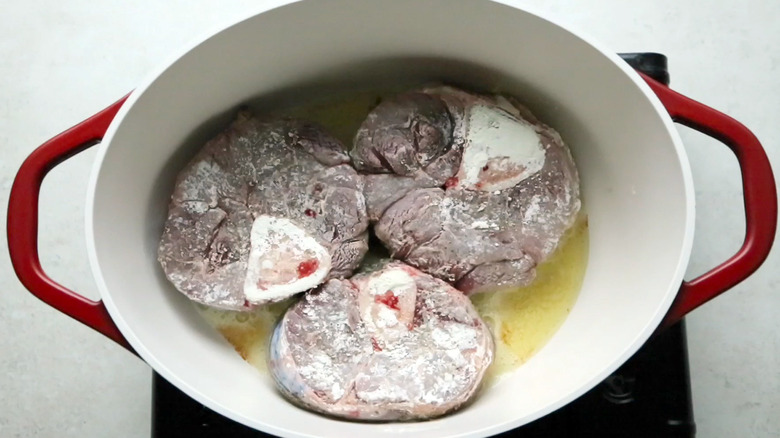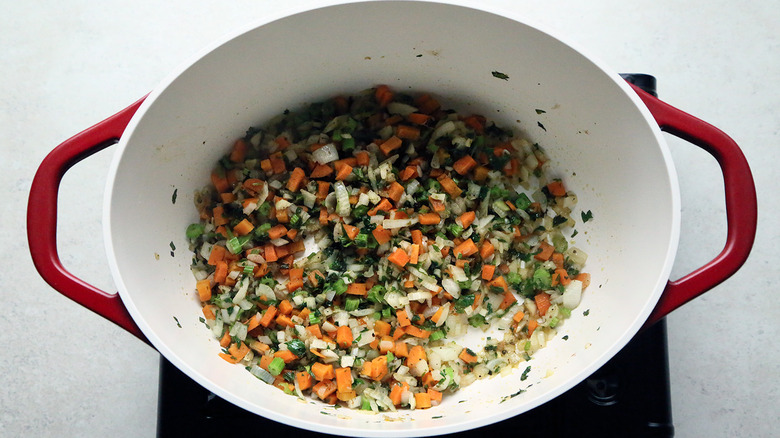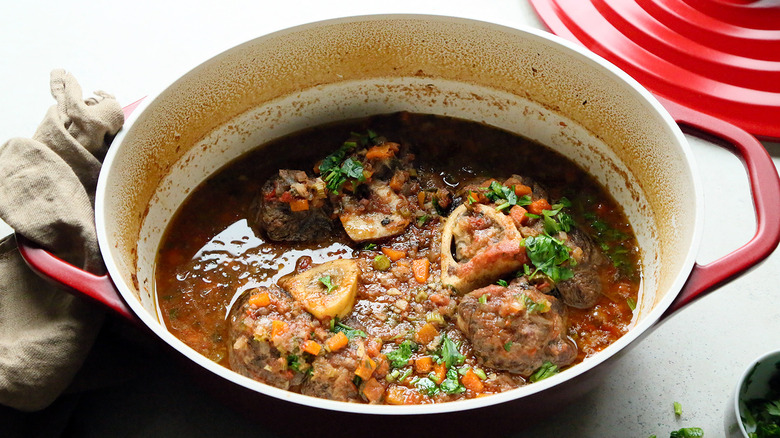Osso Buco-Style Beef Shank Recipe
No matter the time of year, we'd argue that a hearty beef stew has its place on the dinner table. Tasting Table recipe developer Ashley Altan brings us this osso buco-style beef shank recipe that's loaded with flavor and tender fall-off-the-bone meat. Altan explains that osso buco refers to "the marrow hole at the center of the cross-cut veal shank (osso means bone, buco means hole)." While cooking with unfamiliar cuts of beef can be intimidating, we guarantee this recipe is straightforward and easy to follow. You'll be impressing your guests within hours — most of them hands-off.
This dish doesn't only consist of a pot of meat, and Altan describes, "The best part is the slow-cooked mirepoix of onion, carrot, and celery that complements the flavor of this osso buco." As she points out, "The beef juices seep into each vegetable during cooking, creating a deep, umami taste." That's right, the result offers maximum flavor with minimal effort.
Gather the ingredients for this osso buco-style beef shank recipe
Start off by sourcing a few pounds of beef shank. Altan explains that the cut refers to the front leg of the animal, which she describes as "quite tough," noting that it "is often used to make ground beef." Your patience will be rewarded as she adds, "When braised in the oven, you are left with tender fall–off–the–bone meat."
Next, you'll need salt and pepper to season the dish. Measure out 1 cup of loosely packed flour and ¼ cup olive oil to coat and cook the meat. Most of the prep time involves dicing an onion, carrots, celery (with the stems and leaves), and a few garlic cloves. Finally, you'll need dried oregano, beef stock, crushed tomatoes, and freshly chopped parsley for garnish.
Start by prepping the meat
First off, preheat your oven to 375 F, an important step that Altan says will "ensure consistent heat distribution." Meanwhile, pat the beef shanks dry and season them all over with salt and pepper to taste. Next, coat the meat with flour, shaking off the excess.
Set a Dutch oven pot on the burner and heat it to medium-high. Pour in the olive oil to coat the surface and add the shanks. Brown the meat for around 2 to 3 minutes per side, then transfer the shanks to a plate in the meantime.
While the browning step isn't strictly necessary for this type of dish, Altan explains, "To get the maximum flavor out of this dish, sear the beef shanks, creating a golden brown crust around the meat."
Cook the vegetables
Without cleaning the pot, toss in the diced onion, carrot, celery, and garlic. Sprinkle in the oregano and season the dish with salt and pepper to taste. Cook the contents for about 5 minutes until the onions have noticeably softened. Then, pour in half of the beef stock to deglaze the pot and scrape off any browned bits of vegetable from the bottom. If desired, Altan suggests using white wine as an alternative to beef stock.
Add the remaining ingredients, cook, and serve
Pour in the rest of the stock and add the crushed tomatoes to the pot. Stir everything to combine the ingredients and place the beef shanks back into the sauce. Cover the pot with its lid and transfer the dish to the oven. Cook it for 2 hours or until the beef is fork-tender when tested. If you're looking to load up on more vegetables, Altan says, "This traditional osso buco-style beef shank meal may be served with slow-cooked vegetables by adding quartered potatoes, squash, or even bell peppers." If so, "Just add any additional veggies 45 minutes before serving."
Once everything is ready, serve the flavorful meat with extra sauce and garnish it all with freshly chopped parsley. If you end up with leftovers, let them cool completely before transferring them to an airtight container and refrigerating for up to three days or freezing for up to three months. "Any leftover bone with marrow can be used for a rich broth for any soup later," Altan recommends. When you're ready for more, simply transfer the meal to a saucepan and heat it over medium heat or zap it in the microwave.
Osso Buco-Style Beef Shank Recipe
Learn how to make this easy and unique beef shank recipe for fork-tender meat with chopped veggies in broth.
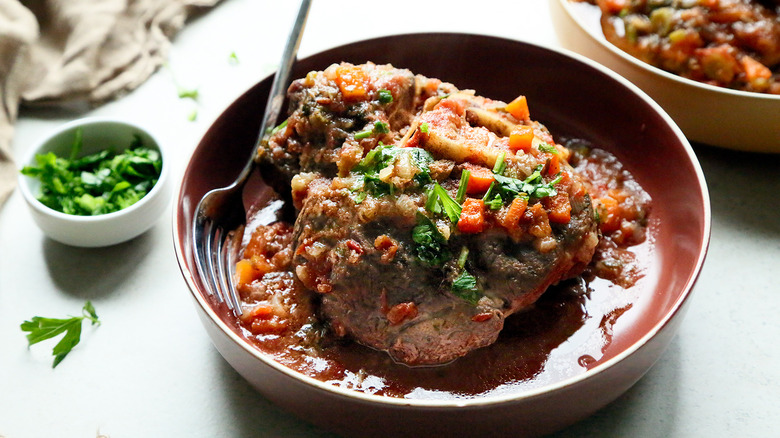
Ingredients
- 3 pounds beef shank
- salt and pepper, to taste
- 1 cup flour, loosely packed
- ¼ cup olive oil
- 1 large onion, diced
- 1 cup diced carrots
- ½ cup diced celery, stems and leaves included
- 3 cloves garlic, chopped
- 1 teaspoon oregano
- 2 cups beef stock, divided
- 2 cups crushed tomatoes
- ¼ cup chopped parsley, to garnish
Directions
- Preheat the oven to 375 F.
- Pat the beef shanks with a paper towel to remove excess moisture.
- Season both sides with a pinch of salt and pepper and coat them in flour, shaking off any excess.
- Place a Dutch oven pot over medium-high heat.
- Once hot, drizzle in the olive oil and add the floured beef shanks.
- Brown the meat for 2 to 3 minutes per side, then remove the shanks from the pot and set them aside.
- In the same pot, add the onion, carrot, celery, garlic, and oregano and season with salt and pepper (about 1 teaspoon each).
- Cook for about 5 minutes until the onions are soft, then add 1 cup of beef stock (or white wine) to deglaze the pot, scraping any bits from the bottom.
- Add the remaining beef stock and crushed tomatoes and stir to combine.
- Add the meat back to the pot and cover it with the lid, then transfer the dish to the oven.
- Cook for 2 hours or until the beef is fork-tender.
- Serve the shanks with the sauce from the pot and garnish with fresh chopped parsley.
Nutrition
| Calories per Serving | 509 |
| Total Fat | 18.4 g |
| Saturated Fat | 4.3 g |
| Trans Fat | 0.0 g |
| Cholesterol | 88.5 mg |
| Total Carbohydrates | 29.0 g |
| Dietary Fiber | 3.8 g |
| Total Sugars | 6.2 g |
| Sodium | 1,108.4 mg |
| Protein | 55.3 g |
